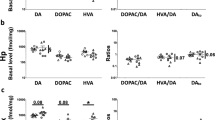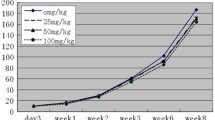Abstract
Many environmental toxins alter reproductive function and affect the central nervous system (CNS). Gonadal steroid hormones cause differentiation of neurons and affect brain function and behavior during the perinatal period, and the CNS is thought to be particularly susceptible to toxic insult during this period. It was, therefore, hypothesized that inhalation of diesel exhaust (DE) during the fetal or suckling period would disrupt the sexual differentiation of brain function in mice, and the effects of exposure to DE during the perinatal period on sexual differentiation related gene expression of the brain were investigated. In the fetal period exposure group, pregnant ICR mice were exposed to DE from 1.5 days post-coitum (dpc) until 16 dpc. In the neonatal period exposure group, dams and their offspring were exposed to DE from the day of birth [postnatal day (PND)-0] until PND-16. Then, the cerebrums of males and females at PND-2, -5, and -16 from both groups were analyzed for expression level of mRNA encoding stress-related proteins [cytochrome P450 1A1 (CYP1A1), heme oxygenase-1 (HO-1)] and steroid hormone receptors [estrogen receptor alpha (ER alpha), estrogen receptor beta (ER beta), androgen receptor (AR)]. Expression levels of ER alpha and ER beta mRNA were increased in the cerebrum of newborns in the DE exposure groups as well as mRNA for CYP1A1 and HO-1. Results indicate that perinatal exposure to DE during the critical period of sexual differentiation of the brain may affect endocrine function.

Similar content being viewed by others
References
Attardi B, Ohno S (1976) Androgen and estrogen receptors in the developing mouse brain. Endocrinology 99:1279–1290
Barraclough CA (1961) Production of anovulatory, sterile rats by single injections of testosterone propionate. Endocrinology 68:62–67
Barraclough CA, Leathem JH (1954) Infertility induced in mice by a single injection of testosterone propionate. Proc Soc Exp Biol Med 85:673–674
Brown TJ, Scherz B, Hochberg RB, MacLusky NJ (1996) Regulation of estrogen receptor concentrations in the rat brain: effects of sustained androgen and estrogen exposure. Neuroendocrinology 63:53–60
Calzà L, Giardino L, Aloe L (1997) NGF content and expression in the rat pituitary gland and regulation by thyroid hormone. Brain Res Mol Brain Res 51:60–68
Dalgaard M, Hossaini A, Hougaard KS, Hass U, Ladefoged O (2001) Developmental toxicity of toluene in male rats: effects on semen quality, testis morphology, and apoptotic neurodegeneration. Arch Toxicol 75:103–109
Dellovade TL, Zhu YS, Krey L, Pfaff DW (1996) Thyroid hormone and estrogen interact to regulate behavior. Proc Natl Acad Sci USA 93:12581–12586
Ferguson SA (2002) Effects on brain and behavior caused by developmental exposure to endocrine disrupters with estrogenic effects. Neurotoxicol Teratol 24:1–3
Fujimoto A, Tsukue N, Watanabe M, Sugawara I, Yanagisawa R, Takano H, Yoshida S, Takeda K (2005) Diesel exhaust affects immunological action in the placentas of mice. Environ Toxicol 20:431–440
Furuta C, Suzuki AK, Taneda S, Kamata K, Hayashi H, Mori Y, Li C, Watanabe G, Taya K (2004) Estrogenic activities of nitrophenols in diesel exhaust particles. Biol Reprod 70:1527–1533
Goldey ES, Crofton KM (1998) Thyroxin replacement attenuates hypothyroxinemia, hearing loss, and motor deficits following developmental exposure to Aroclor 1254 in rats. Toxicol Sci 45:94–105
Gore AC (2001) Environmental toxicant effects on neuroendocrine function. Endocrine 14:235–246
Hany J, Lilienthal H, Sarasin A, Roth-Härer A, Fastabend A, Dunemann L, Lichtensteiger W, Winneke G (1999) Developmental exposure of rats to a reconstituted PCB mixture or aroclor 1254: effects on organ weights, aromatase activity, sex hormone levels, and sweet preference behavior. Toxicol Appl Pharmacol 158:231–243
Hayashi S, Gorski RA (1974) Critical exposure time for androgenization by intracranial crystals of testosterone propionate in neonatal female rats. Endocrinology 94:1161–1167
Hennemann G, Docter R, Friesema EC, de Jong M, Krenning EP, Visser TJ (2001) Plasma membrane transport of thyroid hormones and its role in thyroid hormone metabolism and bioavailability. Endocr Rev 22:451–476
Hiura TS, Kaszubowski MP, Li N, Nel AE (1999) Chemicals in diesel exhaust particles generate reactive oxygen radicals and induce apoptosis in macrophages. J Immunol 163:5582–5591
Hougaard KS, Jensen KA, Nordly P, Taxvig C, Vogel U, Saber AT, Wallin H (2008) Effects of prenatal exposure to diesel exhaust particles on postnatal development, behavior, genotoxicity and inflammation in mice. Part Fibre Toxicol 5:3
Ikeda M, Inukai N, Mitsui T, Sone H, Yonemoto J, Tohyama C, Tomita T (2002) Changes in fetal brain aromatase activity following in utero 2,3,7,8-tetrachlorodibenzo-p-dioxin exposure in rats. Environ Toxicol Pharmacol 11:1–7
Iñiguez MA, Rodriguez-Peña A, Ibarrola N, Aguilera M, Muñoz A, Bernal J (1993) Thyroid hormone regulation of RC3, a brain-specific gene encoding a protein kinase-C substrate. Endocrinology 133:467–473
Iwasaki T, Miyazaki W, Takeshita A, Kuroda Y, Koibuchi N (2002) Polychlorinated biphenyls suppress thyroid hormone-induced transactivation. Biochem Biophys Res Commun 299:384–388
Jacobson JL, Jacobson SW (1996) Intellectual impairment in children exposed to polychlorinated biphenyls in utero. N Engl J Med 335:783–789
Khurana S, Ranmal S, Ben-Jonathan N (2000) Exposure of newborn male and female rats to environmental estrogens: delayed and sustained hyperprolactinemia and alterations in estrogen receptor expression. Endocrinology 141:4512–4517
Kimura T (1975) Persistent vaginal cornification in mice treated with estrogen prenatally. Endocrinol Jpn 22:497–502
Kizu R, Okamura K, Toriba A, Mizokami A, Burnstein KL, Klinge CM, Hayakawa K (2003) Antiandrogenic activities of diesel exhaust particle extracts in PC3/AR human prostate carcinoma cells. Toxicol Sci 76:299–309
Koibuchi N, Chin WW (2000) Thyroid hormone action and brain development. Trends Endocrinol Metab 11:123–128
Koibuchi N, Yamaoka S, Chin WW (2001) Effect of altered thyroid status on neurotrophin gene expression during postnatal development of the mouse cerebellum. Thyroid 11:205–210
Koike E, Hirano S, Shimojo N, Kobayashi T (2002) cDNA microarray analysis of gene expression in rat alveolar macrophages in response to organic extract of diesel exhaust particles. Toxicol Sci 67:241–246
Li HY, Li JF, Lu GW (2003) Neurogranin: a brain-specific protein. Sheng Li Ke Xue Jin Zhan 34:111–115
Li C, Taneda S, Suzuki AK, Furuta C, Watanabe G, Taya K (2006a) Anti-androgenic activity of 3-methyl-4-nitrophenol in diesel exhaust particles. Eur J Pharmacol 543:194–199
Li C, Taneda S, Suzuki AK, Furuta C, Watanabe G, Taya K (2006b) Estrogenic and anti-androgenic activities of 4-nitrophenol in diesel exhaust particles. Toxicol Appl Pharmacol 217:1–6
MacLusky NJ, Naftolin F (1981) Sexual differentiation of the central nervous system. Science 211:1294–1302
McCoubrey WK Jr, Huang TJ, Maines MD (1997) Isolation and characterization of a cDNA from the rat brain that encodes hemoprotein heme oxygenase-3. Eur J Biochem 247:725–732
Mori Y, Taneda S, Hayashi H, Sakushima A, Kamata K, Suzuki AK, Yoshino S, Sakata M, Sagai M, Seki K (2002) Estrogenic activities of chemicals in diesel exhaust particles. Biol Pharm Bull 25:145–146
Nomura M, Korach KS, Pfaff DW, Ogawa S (2003) Estrogen receptor beta (ERbeta) protein levels in neurons depend on estrogen receptor alpha (ERalpha) gene expression and on its ligand in a brain region-specific manner. Brain Res Mol Brain Res 110:7–14
Oberdörster G, Sharp Z, Atudorei V, Elder A, Gelein R, Kreyling W, Cox C (2004) Translocation of inhaled ultrafine particles to the brain. Inhal Toxicol 16:437–445
Oh SM, Ryu BT, Chung KH (2008) Identification of estrogenic and antiestrogenic activities of respirable diesel exhaust particles by bioassay-directed fractionation. Arch Pharm Res 31:75–82
Ohtake F, Takeyama K, Matsumoto T, Kitagawa H, Yamamoto Y, Nohara K, Tohyama C, Krust A, Mimura J, Chambon P, Yanagisawa J, Fujii-Kuriyama Y, Kato S (2003) Modulation of oestrogen receptor signalling by association with the activated dioxin receptor. Nature 423:545–550
Osterlund M, Kuiper GG, Gustafsson JA, Hurd YL (1998) Differential distribution and regulation of estrogen receptor-alpha and -beta mRNA within the female rat brain. Brain Res Mol Brain Res 54:175–180
Payne DW, Katzenellenbogen JA (1979) Binding specificity of rat alpha-fetoprotein for a series of estrogen derivatives: studies using equilibrium and nonequilibrium binding techniques. Endocrinology 105:745–753
Poss KD, Tonegawa S (1997) Reduced stress defense in heme oxygenase 1-deficient cells. Proc Natl Acad Sci USA 94:10925–10930
Reddy VV, Naftolin F, Ryan KJ (1974) Conversion of androstenedione to estrone by neural tissues from fetal and neonatal rats. Endocrinology 94:117–121
Roselli CE, Klosterman SA (1998) Sexual differentiation of aromatase activity in the rat brain: effects of perinatal steroid exposure. Endocrinology 139:3193–3201
Rune GM, Wehrenberg U, Prange-Kiel J, Zhou L, Adelmann G, Frotscher M (2002) Estrogen up-regulates estrogen receptor alpha and synaptophysin in slice cultures of rat hippocampus. Neuroscience 113:167–175
Sagai M, Furuyama A, Ichinose T (1996) Biological effects of diesel exhaust particles (DEP). III. Pathogenesis of asthma like symptoms in mice. Free Radic Biol Med 21:199–209
Shupnik MA, Gordon MS, Chin WW (1989) Tissue-specific regulation of rat estrogen receptor mRNAs. Mol Endocrinol 3:660–665
Sugamata M, Ihara T, Takano H, Oshio S, Takeda K (2006) Maternal diesel exhaust exposure damages newborn murine brains. J Health Sci 52:82–84
Suzuki M, Nishihara M (2002) Gene expression of estrogen receptors, androgen receptor, and aromatase in the neonatal rat hypothalamus. J Reprod Dev 48:17–23
Takahama K, Shirasaki T (2001) Endocrine disruptors and brain estrogen receptors: the current state of behavioral, neurochemical, and molecular biological studies. Nihon Shinkei Seishin Yakurigaku Zasshi 21:103–111
Takano H, Yanagisawa R, Ichinose T, Sadakane K, Inoue K, Yoshida S, Takeda K, Yoshino S, Yoshikawa T, Morita M (2002) Lung expression of cytochrome P450 1A1 as a possible biomarker of exposure to diesel exhaust particles. Arch Toxicol 76:146–151
Takeda A, Perry G, Abraham NG, Dwyer BE, Kutty RK, Laitinen JT, Petersen RB, Smith MA (2000a) Overexpression of heme oxygenase in neuronal cells, the possible interaction with Tau. J Biol Chem 275:5395–5399
Takeda A, Smith MA, Avilá J, Nunomura A, Siedlak SL, Zhu X, Perry G, Sayre LM (2000b) In Alzheimer’s disease, heme oxygenase is coincident with Alz50, an epitope of tau induced by 4-hydroxy-2-nonenal modification. J Neurochem 75:1234–1241
Taneda S, Hayashi H, Sakushima A, Seki K, Suzuki AK, Kamata K, Sakata M, Yoshino S, Sagai M, Mori Y (2002) Estrogenic and anti-estrogenic activities of two types of diesel exhaust particles. Toxicology 170:153–161
Tortosa R, Vidal E, Costa C, Alamillo E, Torres JM, Ferrer I, Pumarola M (2008) Stress response in the central nervous system of a transgenic mouse model of bovine spongiform encephalopathy. Vet J 178:126–129
Tsai CL, Wang LH, Fang LS (2001) Estradiol and para-chlorophenylalanine downregulate the expression of brain aromatase and estrogen receptor-alpha mRNA during the critical period of feminization in tilapia (Oreochromis mossambicus). Neuroendocrinology 74:325–334
Tsukue N, Tsubone H, Suzuki AK (2002) Diesel exhaust affects the abnormal delivery in pregnant mice and the growth of their young. Inhal Toxicol 14:635–651
Vreeburg JT, van der Vaart PD, van der Schoot P (1977) Prevention of central defeminization but not masculinization in male rats by inhibition neonatally of oestrogen biosynthesis. J Endocrinol 74:375–382
Watanabe N, Kurita M (2001) The masculinization of the fetus during pregnancy due to inhalation of diesel exhaust. Environ Health Perspect 109:111–119
Watanabe N, Oonuki Y (1999) Inhalation of diesel engine exhaust affects spermatogenesis in growing male rats. Environ Health Perspect 107:539–544
Weiss B (1997) Endocrine disruptors and sexually dimorphic behaviors: a question of heads and tails. Neurotoxicology 18:581–586
Weiss B (2002) Sexually dimorphic nonreproductive behaviors as indicators of endocrine disruption. Environ Health Perspect 110:387–391
Whitlock JP Jr (1999) Induction of cytochrome P4501A1. Annu Rev Pharmacol Toxicol 39:103–125
Winneke G, Walkowiak J, Lilienthal H (2002) PCB-induced neurodevelopmental toxicity in human infants and its potential mediation by endocrine dysfunction. Toxicology 181–182:161–165
Yoshida M, Yoshida S, Sugawara I, Takeda K (2002) Maternal exposure to diesel exhaust decreases expression of steroidogenic factor-1 and Müllerian inhibiting substance in the murine fetus. J Health Sci 48:317–324
Zoeller TR, Dowling AL, Herzig CT, Iannacone EA, Gauger KJ, Bansal R (2002) Thyroid hormone, brain development, and environment. Environ Health Perspect 110:355–361
Acknowledgments
We thank the members in the Department of Hygiene Chemistry, Faculty of Pharmaceutical Sciences, Tokyo University of Science. This work was supported in part by a grant from CREST of JST and a Grant-in-Aid for Science Research from the Ministry of Education, Culture, Sports, Science and Technology of Japan.
Author information
Authors and Affiliations
Corresponding authors
Rights and permissions
About this article
Cite this article
Tsukue, N., Watanabe, M., Kumamoto, T. et al. Perinatal exposure to diesel exhaust affects gene expression in mouse cerebrum. Arch Toxicol 83, 985–1000 (2009). https://doi.org/10.1007/s00204-009-0459-2
Received:
Accepted:
Published:
Issue Date:
DOI: https://doi.org/10.1007/s00204-009-0459-2




